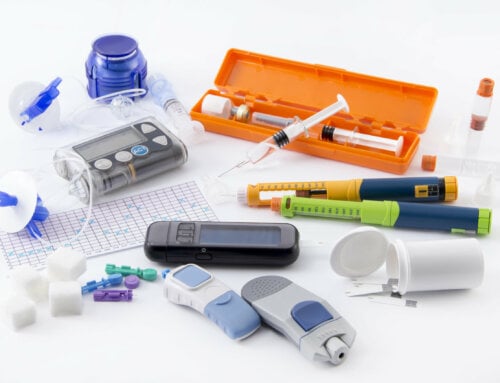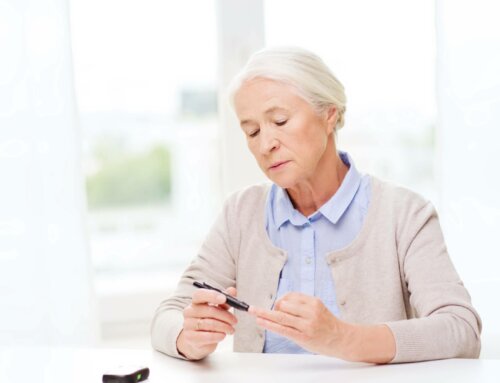Holistic ways to deal with diabetes refer to an overall approach to better control diabetes and its potential complications. While natural remedies and alternative medicine are not a substitute for traditional medications, they may complement your current diabetes self-management routine. Discover 3 holistic ways to deal with diabetes for better health.
Traditional Medication and Lifestyle Changes
The traditional approach to managing diabetes is to diagnose the condition after taking certain blood tests, suggesting and making lifestyle changes, and then prescribing diabetes and heart medications.
Traditional Medications for Diabetes
- Metformin, Glipizide, Trajenta, Invokana, GLP 1s, insulin, statins, blood pressure medications and/or additional medications may be prescribed. Follow the instructions provided by your doctor when taking these medications. Make sure you understand the directions and always check with your doctor before making changes to your medication schedule or dosages. Furthermore, never stop taking your medications without consulting your health care provider. Studies have shown lifestyle changes can help people with diabetes maintain better blood sugar control and reduce the risk of diabetes complications. These complications may include heart disease-heart attack, stroke, heart failure, reduced kidney function leading to kidney failure, blindness, nerve damage and vascular disease and amputation.
Traditional Daily Physical Activity
- Daily physical activity is a specific lifestyle change which might be as effective as your medication when dealing with type 2 diabetes. Include aerobic activities, such as walking, cycling and swimming. Maintain at least 150 minutes a week for benefits. Consider strength training, such as weightlifting and resistance bands, 2-3 times a week for increased muscle mass and a higher metabolic rate.
Traditional Eating Plan
- A balanced diet is a recommendation for traditional lifestyle change. Read, attend a diabetes class and /or visit a dietitian to get the best advice. Look for diabetes-friendly recipes online. Since the ADA guidelines changed in spring 2019, there are no single specific eating plan recommended for people with diabetes. Often recommended by health care providers is the Mediterranean plan. Any chosen eating plan should include plenty of simple whole foods. Choose low-fat dairy products, whole grains such as bulgur, quinoa, amaranth, millet and multi-grain bread, lean meats especially grass-fed and cold water, fatty fish. Fresh, seasonal or plain frozen fruits and vegetables be included daily as well. Processed foods be avoided completely, such as packaged cakes, donuts, crackers, and cookies as well as any fast food. Eliminate sweet drinks. Limit the intake of salty, fatty, greasy and sugary foods. Many doctors advise you to reduce stress in your life and get at least seven-eight hours of sleep, each night. These lifestyle habits can also help minimize the risk of heart disease and high blood pressure. Use a blood pressure machine and blood sugar meter at home to follow your progress. Follow up with your physician if you see elevations in your readings. Remember, no smoking and reduced or no alcohol use is also part of a traditional program to manage your diabetes. These suggestions considered being traditional Western medicine therapies. Let’s examine alternative therapies which can supplement the traditional ones.
Alternative Therapies
A wide variety of disciplines can refer to as alternative therapies. Talk to your doctor about which ones might be helpful to include along with the traditional therapies in your diabetes management plan. Not to mention there are multiple alternative therapies available which may include acupuncture, chiropractic medicine and stress management.
Acupuncture
- Ancient Chinese practitioners pioneered acupuncture more than 3000 years ago. Clinical studies have shown, “Acupuncture could work with traditional diabetes treatment to reduce the impact of some diabetes symptoms.” In fact, acupuncture is a technique used by a licensed practitioner, certified by The National Certification Commission for Acupuncture and Oriental Medicine. The practitioner inserts thin, sterile needles into your skin to treat multiple problems including relieving pain and diabetic neuropathy. Placed into certain meridian points and kept there for 20-30 minutes while you relax in a dark and quiet room. According to The World Health Organization, “Acupuncture is an effective technique for over 100 medical conditions including diabetes.” It can help with weight loss, metabolism, organ function and nerve pain. Cortisol, a hormone released during stress, will be better regulated during acupuncture. Several sessions are usually recommended to target the condition along with a maintenance program to keep the energy flow and channels open. Remember to tell your traditional practitioner that you are using alternative treatments in addition to your regular care.
Chiropractic Medicine/Massage Therapy
- Chiropractic treatments performed by a licensed chiropractor who manipulates the neck and spine for pain relief possibly caused by nerve compression or inflammation. They specialize in the disorders of the musculoskeletal system and the nervous system. The experience is, “hands on” and drugs will not be prescribed. Chiropractors are capable of doing an exam, making diagnoses based on x-rays or MRIs and then recommend specific treatment. The most common procedure done by a chiropractor is a spinal manipulation. This maneuver restores joint mobility which allows your spine and nerves to work to the best of their ability. Spine realignment may also help your immune system and hormone functions. Chiropractic medicine are, “part of an effective plan for peripheral neuropathy, a common diabetes problem.” Early treatment may decrease the harshness of the motor and sensory nerve damage. Chiropractors also focus on positive lifestyle changes to promote your overall health. Make sure to discuss your possible fears and concerns before treatment; you need a relaxed mood during a spinal manipulation.
- Massage therapy is one of the oldest and safest methods practiced ensuring good health; it is the fastest growing complimentary therapy in the United States. ¾ of those seeking massage do it for a specific health complaint, not just for pampering. “Massage therapy is the practice of applying pressure on the muscles and soft tissue by the hands, fingers, forearms and elbows.” Different techniques including strokes, kneading, tapping and vibrations are movements used, depending on your situation. Massage therapy stimulates the lymph system, may assist in lowering blood sugar levels, and removes toxins from the bloodstream. It improves blood circulation which is often needed when you have diabetes. It is also a form of a relaxation technique which may lower both blood glucose and blood pressure. A massage therapist is a professional who can release tight muscles and reduce stress and tension. Most states require a massage therapist to have a license after a massage/bodywork training program and a diploma or certificate in massage therapy.
Stress Reducing Techniques- Guided Imagery, Hypnosis, Biofeedback
- Guided imagery – According to psychotherapist Belleruth Naperstek LISW, BCD, “Guided imagery can lower A1C levels, reduce depressive symptoms and decrease neuropathy in patients with diabetes.” She presented her work to a room full of endocrinologists during their annual, professional meeting. It consists of calming words, soothing music and positive images to create a healing and relaxing experience. Guided imagery is done as a one on one, in a group setting or even self-administered with a recording. It raises endorphin levels, enhances feelings of hope, reduces stress and anxiety, strengthens immunity and relieves pain. It requires no special training and the goal is to reach a peaceful, focused state of mind.
- Hypnosis – Hypnosis is a form of lifestyle therapy which is a cornerstone of diabetes treatment. It is self-taught. A true practitioner is affiliated with a professional society for Clinical and Experimental Hypnosis or The American Society of Clinical Hypnosis. Hypnotized individuals are more open to suggestion and are unconsciously reminded to think and act. In addition, It can improve quality of life, depression, encourage weight loss and may even be effective in blood sugar regulation. Hypnosis treatment is promising in diabetic foot care. Considered as an ancillary method in diabetes care. Let your traditional health care provider know if you are using hypnosis.
- Biofeedback – A non-invasive, non-drug treatment used to lower blood glucose and blood pressure levels in numerous studies; it is another relaxation technique. “Biofeedback is a therapeutic treatment using an instrument that provides information about physiological activity thru skin temperature, muscle tension or electrical brain activity.” The objective is to slow and control stress responses. Therefore, a therapist attached electrodes to the skin or scalp which sends information to a monitoring box. Usually they are one-hour sessions repeated 10-20 times, depending on the problem. You will need to supplement this with 5-10 minute at home relaxation activities.
Aromatherapy
- Aromatherapy is the therapeutic use of essential oils which been dating back to Hippocrates. The essential oils can be inhaled or diluted with a carrier oil and placed topically on the skin. The type of essential oil and the delivery system depends on the symptom. Essential oils come from aromatic plants such as lavender. A smelled fragrance can result in an instant reaction from new or learned behavior. Pleasant smells from these essential oils are invigorating(jasmine), stimulating(lemongrass), peppermint and basil or relaxing (rose and lavender). Aromatherapy can reduce inflammation, aid in cell regeneration and reduce or eliminate infection. It can lower stress and raise coping mechanisms. Just place 3-5 drops of a pure (avoid synthetic oils) essential oil on a cotton ball and breathe in slowly for 5 minutes. Training to become an aromatherapist can come from an online certification.
Tai Chi and Yoga
- Tai chi is an ancient form of meditation that combines breathing techniques and relaxation exercise which may help blood glucose control. Once learned, Tai Chi is practiced anywhere and at any time. It encourages mental relaxation, uplifts moods and reduces stress thru a natural flow of energy. Tai Chi focuses on building strength, balance and flexibility thru slow, deliberate fluid movements; it includes mental imagery and deep breathing. Tai Chi improves cardiorespiratory fitness, muscle strength, peripheral circulation and lowers anxiety. It is slow-moving and easy on the joints and muscles. Find an experienced teacher who has mastered the moves themselves.
- Yoga – For thousands of years, many different types of yoga have been practiced. Some are extremely physically demanding, and others are more relaxed, easy and meditative. Variation of practices may enhance and grow your personal experiences. The original context of yoga was spiritual development to train the body and mind to “self-observe.” It is to raise awareness and lower disease. Certain yoga poses can help both the body and mind relax, improve circulation and lower blood sugars and blood pressure. It enhances mobility, reduces stress and stress hormones, lowers inflammation and insulin resistance, all positive things when you have diabetes.
Talk to your health care team about relaxation exercises and alternative therapies that may benefit you. Licensed and reputable practitioners is a must. Find an alternative therapy that appeals to you and offers benefits you will enjoy. Use it with traditional therapies.
Holistic Herbal Remedies
Herbal remedies are helpful to those with diabetes but should never replace traditional therapies and medications. Always consult with your health care provider before taking any herbal remedies. They are powerful and may cause contraindications with each other and your prescribed medications. Herbal remedies may include dietary supplements, spices or foods.
Chromium is a dietary supplement that may enhance diabetes control by improving insulin action. Ginseng may lower blood sugars and A1C levels.
Alpha – lipoic acid can helpful for diabetic neuropathy.
A magnesium deficiency may lead to poor blood sugar control and taking supplements are helpful. Dietary sources of magnesium are a magnesium pill and include green leafy vegetables and whole grains.
Coenzyme Q10 (CoQ10) has antioxidant properties and helps cells make energy to reduce feelings of fatigue often associated with diabetes. It is especially helpful when you take a statin.
Powerful Foods
Some foods may improve blood sugar control such as ginger and garlic. Ginger known as a spice used for thousands of years; it may lower insulin resistance. Garlic helps fight infection, lowers LDL levels and aids in blood flow. Foods that are rich in fiber and minerals may help blood glucose control such as buckwheat, okra, broccoli and leafy greens. Some studies have indicated cloves, cinnamon, and coffee may reduce inflammation and improve blood sugar metabolism. Cinnamon, a spice made from the bark of a tree and adds instant sweetness to foods. It has antioxidant activity which may improve insulin sensitivity.
Understand that holistic remedies may have inflated commercial claims with little or no scientific evidence. Also, some herbs may cause side effects including rashes, insomnia, anxiety, nausea, increased heartbeat, diarrhea, and vomiting. If you experience side effects, stop taking the product and report any symptoms to your doctor right away.
Prior to trying alternative therapies or herbal remedies always discuss them with your doctor. With the proper supervision, combine with traditional medicine with holistic therapies is a winner. Continue being proactive about your diabetes management plan for the best possible results.







Leave A Comment